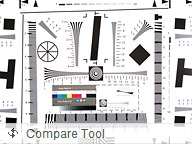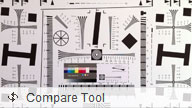HTC One review: To rule them all
To rule them all
Camera features and UltraPixels
The HTC One comes with a camera that's unique in the smartphone world. It's only the second smartphone to feature optical stabilization and it's the first to use a new design which involves photosites that are three times as big as those on a 12MP size. However, since the sensor is equally sized to a 12MP sensor, it only gets to capture a third of the resolution. In HTC marketing talk these larger photosites are calls UltraPixels.
The ultrapixels are bigger than you would get on all other current cameraphones. The Nokia N8 had 1.75-micron pixels, while the 808 PureView and the iPhone 5 both have 1.4-micron pixels. So, each pixel in the HTC One camera is twice the size of a pixel in the 808 and iPhone 5 cameras.
Bigger pixels mean lower noise levels and usually, better dynamic range. Low-light performance is also helped by the Optical Image Stabilization (OIS) as we saw on the Nokia Lumia 920.
The sensor used in the HTC One has a 1/3" diagonal with a 16:9 aspect ratio and it's mounted behind a 5-element lens with F/2.0 aperture. The sensor takes 16:9 photos with 2688 x 1520 pixel resolution, while switching to the traditional 4:3 aspect ratio limits the maximum resolution to 2048 x 1520 pixels, or just over 3MP.
HTC has included a second-generation ImageChip to process the images captured with the camera and also handle the needs of HTC Zoe.
The HTC One continues the trend of using a unified camera interface for stills and video. We didn't like it all that much on the One X and its siblings, but it makes much more sense here. Since the default resolution of the still camera now matches that of the videos - 16:9, so you don't need to worry about framing different aspects on the same viewfinder.
The only remaining complaint is that all still and video settings get dumped into one menu, instead of just getting the relevant settings depending on the current mode, but we can live with that.
Camera interface and image quality
Update, April 30: We've updated our HTC One unit with the latest firmware. It promises to bring improvements over the camera image quality, so we have taken the HTC One camera for a spin once again and changed all the samples. We've also updated the text below to reflect our new findings.
Anyway, the camera interface itself is pretty simple - there are two shutter keys (one for stills and one for video), above them is the gallery shortcut and below is the effects button. On the left side of the screen you get flash mode selector and the Zoe toggle.
Now, we already covered what Zoe does after you've taken a shot, here's how the actual shooting goes. You enable Zoe (an indicator at the bottom of the screen confirms you're in Zoe mode) and tap the still shutter key. The key turns into a progress bar, counting down the three seconds during which the phone records video, reminding you to stay relatively still.
The Optical Image Stabilization offers active correction of the image module in two axis with a frequency of up to 2000 times a second. That, combined with the F/2.0 aperture of the lens and big pixel promises unrivaled low-light performance.
So let's get down to brass tacks here - the image quality. The HTC One promises a lot but does it deliver? Well that depends on the scenario. When used in good lighting condition, the low resolution really takes its toll and while the per-pixel detail level is impressive the total resolving power is quite limited.
Colors are quite decent and images generally look pretty nice when zoomed at 100%, but we were surprised to see that a lot of noise is present. There is some purple fringing, too, so it's not perfect either. Overall, the gamble HTC took with the ultrapixels certainly doesn't pay off when in good lighting conditions. Just about every other high-end smartphone will produce better stills in that scenario.
Update, April 30:The camera samples taken with an HTC One running on the latest firmware are indeed better than the one we've taken with the initial retail unit. There is a bit more detail and the noise has also been reduced a bit. Obviously, HTC fine-tuned its sharpening algorithms, which now do a better job than before. Though the difference isn't huge and not quite enough to let the HTC One catch up with its conventional sensor competitors in good light, but it's still a welcome for anyone who plans to get the flagship.
To put things in perspective we did an impromptu shootout involving the HTC One and the Samsung Galaxy S4. The One was shot in its native 16:9 aspect ratio while the Samsung flagship camera was used to produce the 4:3 samples.
It doesn't take too much effort to spot the kind of advantage the highly-res sensor on the Galaxy S4 has over its rival, ultrapixels or not. Sure, the per-pixel quality of the HTC One is probably a tad better, but the overall amount of captured detail is far superior on the Galaxy S4 photos.




HTC One vs Samsung Galaxy S4 daylight samples
Things change quickly in low light environments, though, as HTC takes advantage of its larger pixels and OIS to retain a level of detail closer to that of its good light shots. The Galaxy S4 on the other hand has no OIS to rely on so it has to push the ISO higher up and noise starts to eat into the fine detail.
Indeed the two cameraphones are on par in the first couple of low-light shots, while the HTC One is already ahead in the second pair, which was taken later in the evening.




HTC One vs Samsung Galaxy S4 low-light samples
So all in all, the HTC One camera might not impress when it comes to shots in good light, but it makes up for it with superior low-light shots. Depending on where and when you do most of your shooting this might make the One the cameraphone of your dreams or a pretty mediocre performer.
The HTC One has HDR support for both its still image and videos. Previously, the company had a hard time tuning that particular feature on its smartphones, but the One is a clear step up. HTC has tuned further the HDR photos with the new firmware and there is no oversharpening. They look pleasant, there is enough detail, lots of detail in the shadows and the in the highlights, and the contrast seems great too.
To wrap up the chapter we've prepared a few macro samples. The HTC One came surprisingly good in this category, allowing us to get really close to the subject and produce some great close-ups. Check them out!
Photo quality comparison
Update, April 30: We've also reshot our photo quality comparison charts with the updated HTC One unit.
The HTC One has made its way to our photo quality comparison tool. HTC's low-megapixel sensor suddenly doesn't feel very comfortable in the controlled environment of our studio and the fact that we had to use the 4:3 mode and waste precious pixels is only part of the reason why. It's just that the first two charts were specifically designed to test absolute resolving power and that's certainly not the low-res sensor's element.



The HTC One in our Photo compare tool
FullHD video camera with HDR
The HTC One can shoot videos at up to 1080p resolution at 30fps. It has an HDR option for the video, but note that the frame rate falls to 28fps, if you enable it and the field of view gets narrower in this mode. It also supports 720p @ 60fps high framerate video recording.
The camera features continuous autofocus and you have the option to lock the focus during video recording, if it hunts too much in dynamic scenes. The videos, of course, benefit from the Optical Image Stabilization as well.
Videos are recorded in MP4 files with an impressive 20Mbps bitrate - among the highest we've seen. Sound is captured in stereo with 192Kbps bitrate and 48kHz sampling rate.
As it turned out the video recording is definitely the better part of the HTC One imaging capabilities. Videos have plenty of detail and the noise is very low. Colors are slightly off, but the built-in OIS makes videos so steady that the overall look is pretty impressive.
Here is a fullHD video sample captured with the HTC we uploaded to YouTube.
HDR video capture is more of the same in terms of detail levels. As for the actual benefits of the two merged exposures we can say that the HTC One produces better HDR videos than the pioneer of the feature, the Sony Xperia Z. The HTC flagship squeezes a good amount of extra highlights and shadows without making its videos appear too flat or unrealistic.
Keep in mind, however, that the field of view get significantly narrower during HDR video capture, which means you'll be able to fit much less into the frame than you normally would.
Here goes the HTC One HDR video that we captured.
There's a 60 frames per second mode on the HTC One but it reduces the maximum resolution to 720p. This doesn't sound too bad, but the actual output is disastrous - the videos look like upscaled VGA samples rather than proper 720p footage. There's very little detail and even though the clips are really smooth, we'd advise you to stay away from this mode.
Here's an untouched 1080p sample (0:10s, 24.6MB) taken straight off the HTC One. You can also download a 720p 60 fps sample (0:30s, 44.0MB) made with the HTC One.
Video quality comparison
We've enlisted the HTC One in our video quality comparison tool. Here it really managed to show what it's capable of, particularly when you look at the low-light video where it easily trashed its competitors.
Reader comments
- D. M
- 10 Oct 2021
- XF1
I had the same worry when I bought the m7. Because last time I had the m8,the main camera was performing less than the front camera
- Paula
- 15 Jan 2021
- XFu
The phone has complicated technology and the battery life is terrible but its sound system is comparable to no other phone.
- Anonymous
- 21 Jul 2019
- vxN
I'm still using my M7 as a backup device of my Huawei Mate 20 Pro. It is, for sure after six years from its debut, an outdated phone with insufficient power to support a lot of modern apps, but its sound system is still amazing in my opinion. The bat...




















